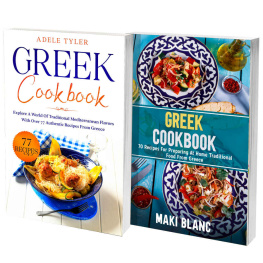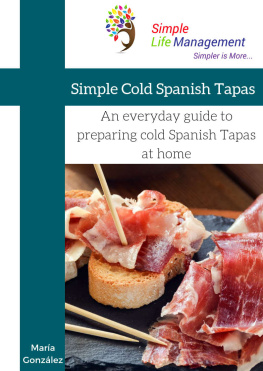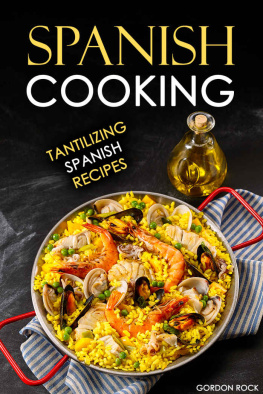MEDITERRANEAN
DIET COOKBOOK
FOR
BEGINNERS
4 Books in 1: 280 Recipes For Healthy French And Spanish Dishes |

Emma Yang
FRENCH
COOKBOOK
70 Easy Recipes For Classic And Modern Dishes From France |

Emma Yang
Copyright 2021 by (Emma Yang) - All rights reserved.
This document is geared towards providing exact and reliable information in regards to the topic and issue covered. The publication is sold with the idea that the publisher is not required to render accounting, officially permitted, or otherwise, qualified services. If advice is necessary, legal or professional, a practiced individual in the profession should be ordered.
- From a Declaration of Principles which was accepted and approved equally by a Committee of the American Bar Association and a Committee of Publishers and Associations.
It is not legal in any way to reproduce, duplicate, or transmit any part of this document in either electronic means or in printed format. Recording of this publication is strictly prohibited and any storage of this document is not allowed unless with written permission from the publisher. All rights reserved.
The information provided herein is stated to be truthful and consistent, in that any liability, in terms of inattention or otherwise, by any usage or abuse of any policies, processes, or directions contained within is the solitary and utter responsibility of the recipient reader. Under no circumstances will any legal responsibility or blame be held against the publisher for any reparation, damages, or monetary loss due to the information herein, either directly or indirectly.
Respective authors own all copyrights not held by the publisher.
The information herein is offered for informational purposes solely, and is universal as so. The presentation of the information is without contract or any type of guarantee assurance.
The trademarks that are used are without any consent, and the publication of the trademark is without permission or backing by the trademark owner. All trademarks and brands within this book are for clarifying purposes only and are the owned by the owners themselves, not affiliated with this document.
Contents
Introduction
French food currently rides a thin line among versions of Haute and nouvelle. The attention being paid to its consistency, taste, and beauty is pure and makes every bit a memorable moment. There is just so much variation with French food, which is the most important quality it does have. French food is now known all over the world because of its elaborate preparation and correct performance. By rendering the regular meal and a result of art, it keeps high in attention and reverence.
French food has undergone many changes in growth, contributing to its prestigious status. They developed their type of cuisine into flavorful, elegant, and stylish dishes. French cooking is a sign of heritage. It's no wonder that the French remain well, lean and slender with all of this strong flavor. Today, the flavor is the biggest coup in French food. In modern culinary classes and cooking training, the techniques used in French food are commonly taught. In reality, Le Cordon Bleu in Paris, France, is among the globe's most popular and highly respected cooking schools.
The core and underlying of many cuisines around the Western world was commonly called French food and preparation. The impact of French Cuisine cooking methods and their appreciation is iconic. That importance is exactly why it can be overwhelming for a novice to learn French cuisine. French cuisine leaves many cooks believing they have to adhere to a certain beauty and elegance unachievable.
"French Cookbook" is a French recipe book. It has six chapters that discuss French cuisine in detail with all the recipes. Chapter one is about a brief introduction to French cuisine and history. Chapter two is about breakfast and appetizer recipes. Chapter four, five, and six are on lunch, dinner, dessert, soups, salads, and the most famous French recipes. Start reading the book now and get yourself ready to prepare delicious French meals to make your day tasteful.
Chapter 1: French Food at a Glance
The foundation and many other delicacies are commonly called French food and cuisine since the impact of traditional French cooking is delightful. French cuisine may sound complicated, but basically, it is about making a cohesive meal, like the coq au vin of Burgundy. You can understand how to create vinaigrette in a particular way so that you can seek one of the easiest recipes around you after you have perfected the salad, including a poultry boast that is all soft and tender within.
1.1 History of French Cuisine
French cuisine varies from rural, woodsy dishes to intricate, fine dining and all in among. Northern France lies at one end of the scale: vine crushing, salt processing, and slow-roasted stews. The Paris custom of elevated dining is from the other end of the spectrum: rich candies, gold-brushed croquembouche, pickling cucumbers, and deep roux. Next to visual pleasure, there is a heavy focus on flavor and spice in Frances food. Flattened red Espelette peppers are produced in the Pyrenees, and fleur de sel flakes cover the Region of Biscays salt mudflats. Even farther south, vineyards make a few of the finest wine and liquor in the country. And much farther down the Mediterranean Sea are the lavender lands and olive trees of Provence.
In the seventeenth century, French food became a blueprint for other foods, in large part. So first of all, this century has seen people start feeding with a fork! While in areas like Italy, the forks were a popular sharpener, the French thought for years that this was a dumb way of dining and used their hands. Intellectual discourse and reading within France had become a hot button topic. During Revolution, cuisine: food was presented as an artistic medium and debated in peace, science, and religion.
In other respects, French food had become more available: by the end of the eighteenth century, well into the 19th, "cuisine bourgeoise" recipe books became quite famous. Usually chocolatey, rich in beef, spices and baked for periods in boiling jus (flavors), this food was an evolution of court-served aristocratic cooking. Instances of this food are local dishes such as boeuf bourguignon, bouillabaisse, coq-au-vin, and gratin dauphinoise, as well as mother roux sauce. In comparison, the French Revolution reached a decisive point in the food industry when it triggered the guild members' collapse. Any French chef could produce and sell any food commodity they desired, with guilds no more operational. This lead to a form of awakening within the French food sector. More gourmet experts have begun to discover numerous pathways for various types of recipes and meals.
1.2 History of Traditional French Dishes
Historically, the background of French cuisine began with explaining culinary contracts and brief recipes in the Middle Ages. Nevertheless, let us skip the Dark Ages and reflect on some of the sweeping reforms that happened after the Revolution and get a better understanding of how French cuisine began in history. Until sugar-mania struck the nation in the sixteenth century, French recipes were commonly acidic-sugar placed in water, vinegar, and fish and meat! In later life, this practice brought about a profound shift in French food patterns: a strong distinction has been made among sweet and salty foods, and at the end of a meal, desserts were regularly served. In French food, the nineteenth century has carried about drastic changes. The globe cuisine is made popular by its elaborate preparation, and the detailed display is modern haute cuisine. It was the French food processing model before food reviewers contested it for being too rigid. A 1970s reaction against the classic strong French cuisine was the latest cuisine. It loosened up the cream sauce and used fewer products to concentrate on the true flavors. It is noticeable in today's specific French cooking by versatile preparing procedures and further experimenting with non-traditional varieties. French food has undoubtedly lost some of its global hegemons. There are so many exciting outsiders to the global fine dining scene who have exceeded the existing French chefs. The continued success of today's French food is not insignificant.






